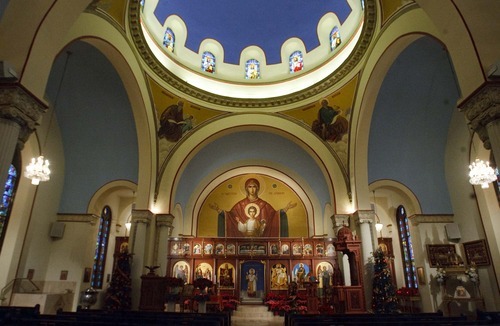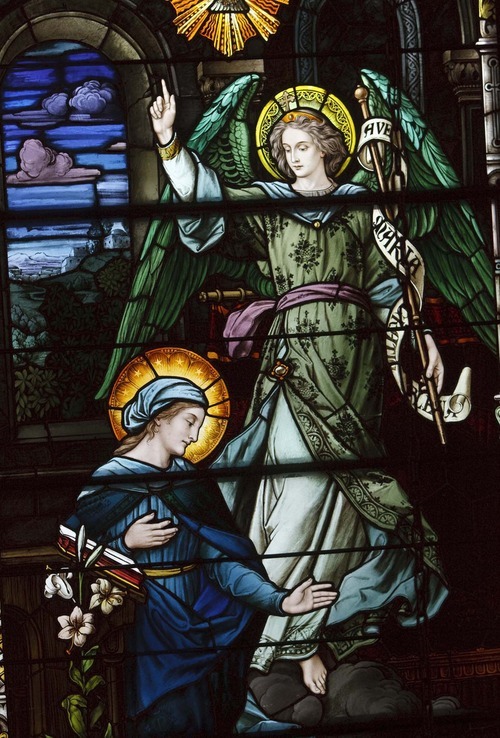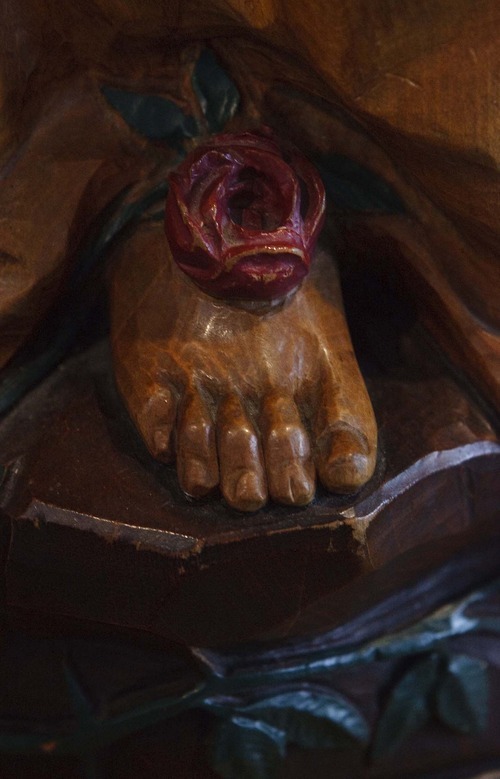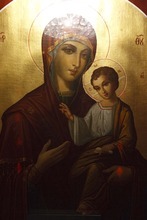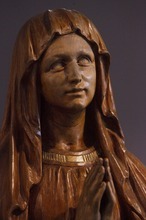This is an archived article that was published on sltrib.com in 2011, and information in the article may be outdated. It is provided only for personal research purposes and may not be reprinted.
Mary's eyes are large and mournful, her head encircled by a golden globe, arms outstretched, long fingers peeking out beyond her red robe. A miniature man — the Son of God — sits on her lap, with limbs similarly elongated and uplifted.
The proportions are wrong. Perspective is distorted. Noses are longer, eyes sharper. Symbols abound.
At a glance, viewers may recognize it as Christian Orthodox art and that the two-dimensional style is no accident. It's a matter of faith and theology.
"This is not an expression of physical beauty," says Father Matthew Gilbert, of Salt Lake City's Holy Trinity Greek Orthodox Church, "but spiritual beauty."
And kissing such sacred images is an expression of love, not idol worship, he says. When people kiss a photograph of a distant or deceased beloved, they don't love the picture "but what it represents."
In the same way, Orthodox believers embrace these unique images of Jesus Christ, Mary and the saints who have gone before.
"We venerate the icon," Gilbert says. "We worship God alone."
But the distinction hasn't always been this clear, especially to those who saw veneration as little more than idol worship, strictly forbidden in the Bible's Ten Commandments.
Indeed, the use of icons in Christian worship was hotly contested in the ancient world. Then, as now, the relationship between art and faith was endlessly dissected for the possibility of blasphemy or, worse, paganism.
Ultimately, the embrace of icons contributed to a divergence in the spirituality of the Eastern and Western branches of Christianity and led to different artistic expressions of the same faith.
Creating the right image
It didn't take long after Jesus died for his followers to wrestle with how to understand the Messiah in their midst.
Was he God or man or both? How should he be worshipped?
At the same time, these newly minted Christians were wrangling with the surrounding Greek and Roman cultures, which bowed before deities and emperors. It was idol worship at its worst, soundly condemned by the Bible and by disciples such as Paul.
Eventually, the church came to define the Christian Savior as human and divine. So what did that make Mary? Some bishops viewed her as the mother of only the human Jesus, while others believe she gave birth to both.
In A.D. 431, the Council of Ephesus declared that Mary was "Theotokos," or God-bearer. It thus spelled out the kinds of images that such a role demanded.
"The icons of Mary are very specific," says Diane Apostolos-Cappadona, who teaches religious art and cultural history at Georgetown University in Washington, D.C. "She was never to be seen without the child and was always to be venerated in terms of her role, not by herself ."
This theology is revealed, for example, in the way the iconic mother holds the baby.
If he is touching her cheek, Mary is relating to him with warmth as a "sweet friend," Apostolos-Cappadona says. If they are both sad, this represents the pre-knowledge of Christ's passion, death and resurrection.
Such icons suggest this baby was born to die and the compassionate Mary stands in for all suffering mothers.
Sometimes she is depicted as a nursing mom, with the "sweet milk of paradise and reality," Apostolos-Cappadona says. "You would never survive if your mother didn't have milk. The nursing-mother image is a very fundamental comment about the sustenance of life on Earth."
But viewing these icons was not like worshipping Zeus or adoring a Roman emperor.
"You pray through the icon to keep it from being an idol," Apostolos-Cappadona says. "Icons are understood to be thresholds, opening a window to the meaning of an event. They are not portraits and not idolatrous because they are not naturalistic."
Not all church fathers, however, agreed.
Wrestling with meaning
In A.D. 600, Pope Gregory the Great had to settle a raging artistic debate.
He issued a letter to Serenus, the bishop of Marseille, who had ordered the removal of all images from churches in his region. Gregory writes back to stop the removals, saying that art is "biblia pauperum," meaning "the Bible of the poor." He was speaking, it seems, not of the impoverished masses but of the textually illiterate.
These images told the stories of Jesus for those who could not read. They were educational, rather than experiential, as they were seen in the East.
The battle between those favoring icons and those opposing (iconoclasts) wasn't settled at that time, but continued for a couple of more centuries with various popes and bishops leading the skirmishes.
In the 700s, two bishops wrote to the patriarch in Constantinople, saying their Christians were being accused of idol worship by Jews.
The patriarch wrote back in support of images, says James Skedros, Cantonis Professor of Byzantine Studies and professor of early Christianity at Holy Cross Greek Orthodox School of Theology in Brookline, Mass.
Later, Pope Leo III banned icons again.
He was wondering why the church wasn't thriving or winning battles, says Skedros, who grew up in Utah, and thought maybe it was because they "were worshipping God wrong."
The main justification for icons was made in 787 by St. John of Damascus at the Second Council of Nicea, which clearly distinguished between veneration and worship.
In the East, two-dimensional pieces spoke to a "spiritual union of God and man," Skedros says. "The artists consciously avoided presenting a snapshot of reality, leaning instead toward something different, more mystical."
Contrasting approaches
Through the ages, the differences between the two artistic traditions grew wider.
Roman Catholics opened up the world of Christian art to many forms, including stained glass, realistic paintings and statues to express their faith. The purpose was didactic, but the techniques were fluid.
With its approach to art, Skedros says, Western Christianity was "laying the groundwork for a cultural revolution known as the Italian Renaissance."
Catholic art "provides emotional involvement as well as a spiritual one," says Marty Seiner, an independent artist who serves on the liturgical arts committee for Salt Lake City's Catholic Diocese. "There is nothing definite about the way Catholic artists create religious images. They are way more naturalistic and three-dimensional."
These differences between East and West remain today, though some Catholics such as Seiner have learned to appreciate the geometric patterns and strict traditions of icon-making.
"The icon was described as written by the hand of God," she says. "It is a divinely inspired translation of the holy image into line, color and form, just as texts are translated from one language to another."
Catholics still see the educational purpose in religious art, even in an era of broad literacy.
"When it comes to Mary and any representation of the saints, we [Catholics] are simply trying to honor people who were friends of God," says Deacon Lynn Johnson, of Salt Lake City's Catholic Diocese. "We venerate them for what they accomplished, Mary in particular. For us, Mary represents the whole idea of holiness — what God wants and what I want are the same."
To Johnson and the Catholics, Mary's acceptance of God's plan for her is a story that needs to be told anew in every generation — and art is a grand narrator.
The art of faith — the final act
This is the final monthly installment of a yearlong series in The Salt Lake Tribune on religious art. Today: The differences between Eastern and Western Christian art. To view previous stories in the series, visit the links above.



